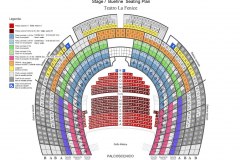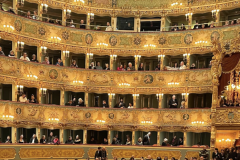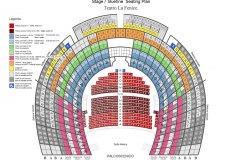The Clemency of Titus
November 2025 | ||||||
|---|---|---|---|---|---|---|
Mo | Tu | We | Th | Fr | Sa | Su |
Openin Opera Season
For the Opening Opera night Season on Thursday, November 20, 2025, black tie is required
La clemenza di Tito – Wolfgang Amadeus Mozart | Opera
with Italian and English surtitles
Synopsis
Place and time: Ancient Rome, in the year 79.
Act 1
Vitellia, daughter of the late emperor Vitellius (who had been deposed by Tito's father Vespasian), wants revenge against Tito. She stirs up Tito's vacillating friend Sesto, who is in love with her, to act against him (duet "Come ti piace, imponi"). But when she hears word that Tito has sent Berenice of Cilicia, of whom she was jealous, back to Jerusalem, Vitellia tells Sesto to delay carrying out her wishes, hoping Tito will choose her (Vitellia) as his empress (aria "Deh, se piacer mi vuoi").
Tito, however, decides to choose Sesto's sister Servilia to be his empress, and orders Annio (Sesto's friend) to bear the message to Servilia (aria "Del più sublime soglio"). Since Annio and Servilia, unbeknownst to Tito, are in love, this news is very unwelcome to both (duet "Ah, perdona al primo affetto"). Servilia decides to tell Tito the truth but also says that if Tito still insists on marrying her, she will obey. Tito thanks the gods for Servilia's truthfulness, and immediately forswears the idea of coming between her and Annio (aria "Ah, se fosse intorno al trono").
In the meantime, however, Vitellia has heard the news about Tito's interest in Servilia and is again boiling with jealousy. She urges Sesto to assassinate Tito. He agrees, singing one of the opera's most famous arias ("Parto, parto, ma tu, ben mio" with basset clarinet obbligato). Almost as soon as he leaves, Annio and the guard Publio arrive to escort Vitellia to Tito, who has now chosen her as his empress. She is filled with feelings of guilt and worry over what she has sent Sesto to do.
Sesto, meanwhile, is at the Capitol wrestling with his conscience (recitativo "Oh Dei, che smania è questa"), as he and his accomplices set about burning it down. The other characters (except Tito) enter severally and react with horror to the burning Capitol. Sesto reenters and announces that he saw Tito slain, but Vitellia stops him from incriminating himself as the assassin. The others lament Tito in a slow, mournful conclusion to act one.
Act 2
The act begins with Annio telling Sesto that Emperor Tito is in fact alive and has just been seen; in the smoke and chaos, Sesto had mistaken someone else for Tito. Sesto wants to leave Rome, but Annio persuades him not to (aria "Torna di Tito a lato"). Soon Publio arrives to arrest Sesto, bearing the news that it was one of Sesto's co-conspirators who dressed himself in Tito's robes and was stabbed, though not mortally, by Sesto. The Senate tries Sesto as Tito waits impatiently, sure that his friend will be exonerated; Publio expresses his doubts (aria "Tardi s'avvede d'un tradimento") and leaves for the Senate. Annio begs Tito to show clemency towards his friend (aria "Tu fosti tradito"). Publio returns and announces that Sesto has been found guilty and that his death sentence only awaits Tito's signature.
Attempting to obtain further details about the plot, the anguished Tito decides to send for Sesto first. Sesto takes all the guilt on himself and says he deserves death (rondo "Deh, per questo istante solo"), so Tito tells him he shall have it and sends him away. But after an extended inner struggle, Tito tears up the execution warrant for Sesto. He determines that, if the world will accuse him (Tito) of anything, it should charge him with showing too much mercy, rather than with having a vengeful heart (aria "Se all'impero").
Vitellia at this time is wracked with guilt, but Servilia warns her that tears alone will not save Sesto (aria "S'altro che lagrime"). Vitellia finally decides to confess all to Tito, giving up her hopes of empire (rondo "Non più di fiori" with basset horn obbligato). In the amphitheatre, the condemned (including Sesto) are waiting to be thrown to the wild beasts. Tito is about to show mercy, when Vitellia offers her confession as the instigator of Sesto's plot. Although shocked, the emperor includes her in the general clemency he offers (recitativo accompagnato "Ma che giorno è mai questo?"). The opera concludes with all the subjects praising the extreme generosity of Tito; he then asks that the gods cut short his days, should he ever cease to care for the good of Rome.
Program and cast
Tito: Daniel Behle
Vitellia: Anastasia Bartoli
Servilia: Francesca Aspromonte
Sesto: Cecilia Molinari
Annio: Nicolò Balducci
Publio: Domenico Apollonio
Conductor: Ivor Bolton
Director: Paul Curran
La Fenice Orchestra & Choir
Chorus Master Alfonso Caiani
La Fenice staging
with Italian and English surtitles
The cast is subject to change
Teatro La Fenice
Teatro La Fenice ("The Phoenix") is an opera house in Venice, Italy. It is one of the most famous theatres in Europe, the site of many famous operatic premieres. Its name reflects its role in permitting an opera company to "rise from the ashes" despite losing the use of two theatres (to fire and legal problems respectively). Since opening and being named La Fenice, it has burned and been rebuilt twice more.
The Teatro La Fenice was founded in 1792. In the nineteenth century, the theatre staged the world premieres of numerous operas, including Rossini’sTancredi, Sigismondo and Semiramide, Bellini’s I Capuleti e i Montecchi (The Capulets and the Montagues) and Beatrice di Tenda, Donizetti’sBelisario (Belisarius), Pia de’ Tolomei, and Maria de Rudenz, and Verdi’s Ernani, Attila, Rigoletto, La traviata and Simon Boccanegra.
In the last century, the Fenice has also placed a special emphasis on contemporary productions, welcoming the world premieres of Stravinski’s The Rake’s Progress, Britten’s The Turn of the Screw, Prokofiev’s L’angelo di fuoco (The Fiery Angel), Nono’s Intolleranza (Intolerance) and Maderna’s Hyperion. Recent premieres have included Kagel’s Entführung im Konzertsaal (Kidnapping in the Concert Hall), Guarnieri’s Medea, Mosca’s Signor Goldoni and Ambrosini’s Il killer di parole (The Killer of Words).
With a seating capacity for over one thousand people, the Fenice boasts excellent acoustics (which were improved when the theatre was rebuilt after the devastating fire of 1996), a 98-member orchestra and 66-person opera chorus, a dedicated local audience and a large international following. The theatre is a leading creative venue, staging more than one hundred opera performances per year, a major symphonic season conducted by prominent conductors from across the globe (including frequent collaborations with Myung-Whun Chung, Riccardo Chailly, Jeffrey Tate, Vladimir Temirkanov and Dmitrij Kitajenko), the full cycles of symphonies by Beethoven, Schumann, Brahms and Mahler, a contemporary repertoire focused especially on Venetian artists such as Nono and Maderna, ballets, and chamber music concerts.
The theatre is owned by the Municipality of Venice and managed by the Fondazione Teatro La Fenice, a private body whose members include the State of Italy, the Veneto region, the Municipality of Venice and numerous public and private institutions. The foundation also runs a second theatre, the Teatro Malibran (formerly known as the Teatro di San Giovanni Grisostomo), which dates back to 1678.
The leadership of the Fondazione includes General Manager Cristiano Chiarot, Artistic Director Fortunato Ortombina, Principal Conductor Diego Matheuz and Chorus Master Claudio Marino Moretti.
Transport
Vaporetto
from Tronchetto: line 2
toward Rialto bridge, St Mark and Lido
from Piazzale Roma and the Santa Lucia train station: line 1 or line 2
toward Rialto bridge, St Mark and Lido
stops: take line 1 to Rialto bridge, St Angel, St Samuel or St Mark (Vallaresso);
or take line 2 to Rialto bridge or St Mark (Vallaresso)
Alilaguna public transportation service from the Marco Polo airport - take the orange line to Rialto bridge or the blue line to St Mark (Vallaresso)
Parking: although you can drive to Venice, cars, bicycles and mopeds are not permitted in the city. You can leave your vehicle in one of the parking garages on Tronchetto or in Piazzale Roma:
Entrances
La Fenice Opera House has two entrances:
- the stage door is for theatre staff and performers only and is manned by a doorman;
- the main entrance
Lifts
The boxes, gallery and family circle can be reached via elevators
Access
The theatre complies with all legal regulations regarding special needs accessibility.

 EN
EN DE
DE IT
IT FR
FR ES
ES RU
RU JP
JP RO
RO
 Seating plan
Seating plan 
